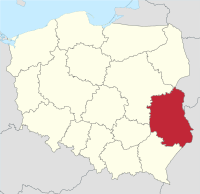Lubelskie
Lublin Voivodeship (Polish: województwo lubelskie [vɔjɛˈvut͡stfɔ luˈbɛlskʲɛ]) is a province of Poland. Together with the Małopolskie region it has a lot of Jewish heritage, especially in the capital Lublin and the area south of it. This heritage has a sombre conclusion in Majdanek (which is in the city area of Lublin), Bełżec and Sobibór.

Regions
- Polesie — one of the largest European swampy areas, a small part of it is in Poland
- Roztocze — a range of picturesque hills in the south of the voivodeship
Cities
- 🌍 Lublin — the biggest city and capital, it has a well-preserved old town with typical Polish and unusual Renaissance architecture, the so-called Lublin Renaissance
- 🌍 Chełm — Baroque town in the Lublin Voivodeship with underground routes beneath the market square
- 🌍 Kazimierz Dolny — Renaissance town with beautiful market square at the Vistula
- 🌍 Lubartów
- 🌍 Terespol — a border town on the Bug River opposite to the Belarusian city of Brest
- 🌍 Włodawa — Baroque town in the Lublin Voivodeship at the Bug River
- 🌍
Zamość — pearl of the late Renaissance and Mannerist architecture of the perfect humanist, its old town is a

Spa towns
- 🌍 Krasnobród — spa in the Roztocze area
- 🌍 Nałęczów — spa near Kazimierz Dolny
Other destinations
Understand
In the early middle ages the region of Lublin was on the borderland between the Kingdom of Poland and Ruthenia. Later, it became part of Lesser Poland which was the major part of Poland since the Polish capital was moved from Gniezno to Kraków in 1040. Lublin played an important part in the Polish-Lithuanian Commonwealth, as it was here, that the Union of 1569 was signed, the constitution of the Commonwealth. The highest court of the Commonwealth was also situated in Lublin since the 1580s. During the Renaissance a unique and beautiful kind of architecture developed in this region, the so called Lublin Renaissance. Beautiful castles and palaces and whole cities ware built in the 16th and 17th century in the region of Lublin. Also the greatest Polish Renaissance poets and writers came from this region. After the Third Partition of Poland in 1795 most of its territory was annexed by Austria, but became independent as part of the Duchy of Warsaw between 1807-1815. After the Congress of Vienna it became part of the Kingdom of Poland, ruled by the Russian Tsar. After World War I the region of Lublin became part of the Second Polish Republic, but was occupied by Nazi Germany between 1939 and 1944, when it was part of the German Generalgovernement. After World War II it again became part of Poland. Nowadays it is in the east of Poland, although it was a central Polish region in the time of the Commonwealth.
Get in
By plane
Lublin has its own small airport, with a train station inside the airport terminal providing quick and easy access to Lublin's rail network.
By bus
Flixbus, together with several local companies, offer services from both Kraków and Warsaw to Lublin. Some of these services stop in Puławy too. The coach station in Lublin is very near to the historical city center, on the other side of Aleja Solidarności.
By train
PKP Intercity, the national railway company, operates many connections between Lublin, the regional capital, and other Polish cities. The most frequent direct connection is with Warsaw, which takes more than 3 hours due to construction works. These works are expected to last until 2019. Other direct train services operate to Kraków, Katowice, Kielce or Wrocław.
Get around
Lublin is the hub of regional transport in the region. There are good railway connections on the line Dęblin, Puławy, Nałęczów, Lublin. There are also some trains to Chełm, some continuing to the Ukrainian capital Kiev. If you want to travel to other places in the region then regional buses are the best option with some local hubs in Chełm, Biała Podlaska and Zamość.
See
UNESCO World Heritage sites
- Zamość - a planned picturesque Renaissance town in the south of the province. It was inscribed on the UNESCO World Heritage List in 1992.
Do
- Go underground in the Chełm chalk tunnels.
- Enjoy the landscape in Kazimierz Dolny, Roztocze National Park and Poleski National Park.
Eat
Drink
The Perła brewery is in the city of Lublin. This brand is quite popular in this region. The city also boasts a vodka distillery which is called Lubelska.
Stay safe
Poland, and Eastern Poland in particular, has an undeserved reputation for criminal activity. However, a traveler will find most Poles in the Lublin area to be extremely helpful and politely interested in foreigners, if not a bit shy. It is advisable to take standard precautions, but the area is very safe.
Go next
Lublin Voivodeship borders three other Polish provinces:
as well as Belarus and Ukraine.